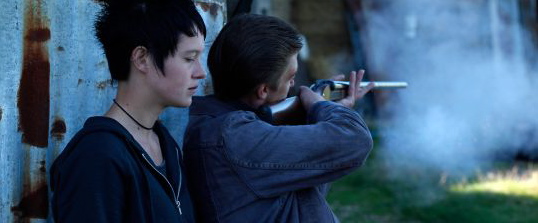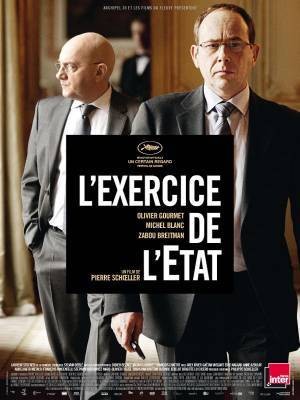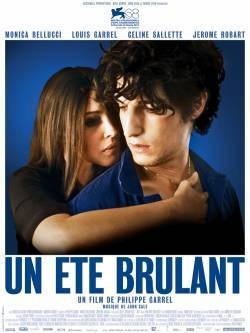BRUNO DUMONT: HORS SATAN (2011)
ALEXANDRA LEMATRE AND DAVID DEWAELE IN OUTSIDE SATAN
Poverty poetry
Hors Satan (Outside Satan) is vintage Bruno Dumont, elemental, brutal, poetic, nearly dialogue-free. Its main character (played by David Dewaele, also seen in Hadewijch) known only as "le Gars," "the Guy," is one of Dumont's odd rural types, small and lean, with a faroff look, his face pinched and shopworn. But also many other things. The film is all about faces. Almost all the action takes place outside, and the rough, unspectacular rolling landscape -- the other ever-present main character -- provides beautiful colors and lights that, shining on the face of "le gars," make it at times seem transcendent and beautiful. He is, after all, "outside Satan," beyond good and evil, because he can both murder and cure, crush and bring back from the dead, and humbly, unspectacularly, mysteriously, is ready to disappear, like Caine in Kung Fu, wandering the earth.
In a sense Hors Satan isn't "about" its action or its characters at all. It's pure cinema, creating a world out of nothing, like Lisandro Alonso in Los Muertos, with a Carl Dreyer-esque breath of transcendence such as Carlos Reygadas introduces into the Mexican Menninites in Silent Light. But of course there is not the suspenseful narrative of Los Muertos or the rich social world of Silent Light. This could only be Dumont, and those who like his work will love it and those who dislike it will hate it. This is abstract art, ugly-beautiful, and it will hypnotize you if you don't ask it too many rational questions; if you want something linear, progressive, and parsable, you'll squirm in your seat. If you let it flow over you, it sings in that strange way Dumont's best films do. With reserve but some fairness, Variety's critic Rob Nelson, calls the film "Maddening, pretentious, hypnotic and transcendent in roughly equal measure." More of a non-responder is the reviewer for Hollywood Reporter, whose critique is summed up thus: "Inarticulate characters, long blank stares, forced camera angles and allegorical nonsense make up this pretentious study in quasi-religious ennui." But then, one man's ennui is another man's trancelike state. The inarticulate characters evoke great silent film. The long blank stares allow the camera to explore the complexity of the faces. The "focrced camera angles" balance intimacy with detachment. The pretentious study allows simplicity to become reverberant richness.
Le Gars is a loner with a rifle who poaches and builds fires. He's joined by the sad, punkish girl known only as "Elle," "She" (Alexandra Lematre), who forms a bond with him, brings him food, prays with him, and makes a kind of platonic love by simply resting her head briefly on his shoulder, a curiously touching and meaningful gesture in this minimal and heightened world. Le Gars has powers that include immunity from detection when he commits acts that in ordinary terms are criminal. He kills Elle's abusive father, and a young man who has bothered her. What he does with an earthy female backpacker (Aurore Broutin) is harder to interpret. He brings Elle back to life. And then, like Caine, he hoists a makeshift sack on his back and wanders off.
But somehow that's not what Hors Satan is about at all. To begin with, these acts, these deaths, are understated, and seem like only poaching or taking potshots or carrying a heavy burden across a field. What happens on the screen is more about the sound of the wind; the rain; brush fire across the horizon recalling a photo by Bernard Faucon (but without the ragged boys); rich, beautiful grasses, dunes, and marshes; and the narrow river. (This is the Côte d'Opale region of France bordering on Belgium.) The wide aspect ratio contributes to this sense of a living, ever-present landscape that envelops the characters. This is why the camera often drops back to a long shot, a device Dumont has used often, in his war picture -- Flandres, for instance. Dumont works with poverty: poverty of landscape, of personality, of speech and emotion. This goes back to L'humanité (1999), with its rape, murder, police investigation, and unsolved mysteries. I remember walking out of the theater debating the film with a stranger, and that's what you could do with Hors Satan. That's what Dumont wants you to do, I suspect. If his films were more linear and coherent, if they didn't have elements that shock and confuse, they wouldn't awaken those raw feelings in viewers and start them thinking and arguing.
Meanwhile, thanks to smooth, textbook editing by Dumont and Basile Belkhiri, with blackouts separating main sequences; fine work by cinematographer Yves Cape; and sound design by Emmanuel Croset so precise even the footsteps on grass have a distinctive echo, Hors Satan looks and sounds perhaps better than any previous Bruno Dumont film, achieving beauties and religious overtones without the overt references resorted to in Hadewijch.
Hors Satan debuted at Cannes and has been in other international festivals. It opened in Paris October 19, 2011, to excellent reviews. Cahier du Cinéma's critic thought it "perhaps.... in the simplicity of the fable and the impressive economy of the mise en scène, his most direct and most beautiful film."
Screened for this review October 25, 2011 at MK2 Danton cinema in Paris, where the respectful and substantial matinee audience suggested increasing acceptance of Dumont by the French filmgoing public. Outside Satan opened in NYC 18 Jan. 2013 to generally favorable reviews (Metacritic: 63).





 Reply With Quote
Reply With Quote




Bookmarks